GNOSIS: A Prototype Operating System for the 1990’s
Bill Frantz
Norm Hardy
Jay Jonekait
Charlie Landau
Tymshare Inc.
Cupertino, California
Copyright © Key Logic, Inc., 1979. All rights reserved.
Permission to reproduce and redistribute this document in paper or
electronic form is hereby granted, provided that this copyright notice
remains intact.
HTML edition Copyright © Jonathan Shapiro, 1995. All rights
reserved. Redistribution is permissible under the same terms as
before. There have been some changes from
the original version.
This session offered a brief introduction to the GNOSIS operating
system being developed by TYMSHARE, INC. to run on 37O architecture
hardware. GNOSIS offers new approaches to solving the inherent
problems of security, auditability, and reliability which are a result
of the basic design of current systems.
The presentation covered the motivation for building the system,
the key architectural features which distinguish it from current
systems and an introduction to the implementation and application
conversion concepts.
The text of the presentation follows.
This session is being sponsored by the Basic Systems Division, by
the LSRAD task force as a kind of consciousness raising
session. Gnosis, which stands for the Great New Operating System In
the Sky, is an example of a completely different kind of operating
system. We would like for you to leave this presentation with the
thought that all operating systems do not need to be alike. Perhaps
Gnosis is not the best of all possible worlds for all users, but it
does demonstrate that there are other ways to solve problems.
Gnosis is being developed by TYMSHARE as a proprietary control
program. We will develop proprietary application packages to run on
it, as will our customers. My management has asked me to emphasize
that we won’t be giving Gnosis away, and SHARE management has asked me
not to say that it is for sale.
We will have three short presentations this morning, to be given
by the other individuals who, along with myself, Constitute the entire
Gnosis design, implementation, testing, documentation, and for now,
marketing group. Norm Hardy, the senior architect who is solely
responsible for getting the project started, will speak first on the
reasons we are building Gnosis. Then Bill Frantz will explain the
design concepts of Gnosis. Finally, Charlie Landau will give a very
brief introduction to the implementation of Gnosis.
1. Introduction and Background
Norm Hardy
1.1. Why do we start another operating system?
We don’t know well enough how our current operating systems work!
Even VM, which is much smaller than MVS, is not clearly organized
around principles that allow one to understand all of the
ramifications of a change. There certainly were principles in the
designers’ minds. They were highly experienced and excellent
designers, but these principles were unrecorded and the system has
been modified by people who were unaware of those design
principles. They can only be guessed by reading code. If guessing
wrong causes quick crashes you can guess again. Otherwise you just
contribute to the gradual deterioration of a large system by enhancing
its function or even fixing bugs. This is one explanation of the
suspected phenomenon where fixing a bug in MVT tends to increase the
number of bugs.
The systems that we build today are not reliable enough. The
problems that we have ascribed to operating systems apply equally to
large application programs. We must change software to add new
function and we cannot tolerate resulting unreliability.
Some applications are hard or infeasible now. During the past ten
years in the computer service business we have missed many
opportunities because of the lack of operating system features. Let me
give you a couple of examples:
- Imagine an owner of a data base that provides a number of
vital statistics for each company in the United States with
sales larger then $50,000 per year.
This is very valuable data. It is very expensive to produce
and maintain. Unrestricted access to this data commands a high
price. There are a few very large users that will pay a high
price for virtually unlimited access to the data. There are
also a large number of users who cannot afford that price but
will pay a much smaller price for limited views of the
data. Thus less extensive data and summary information have a
smaller market value but can be derived from the complete data
base. (This is an example of segmentation of the data market.)
If we want to limit one user to seeing certain fields,
IBM’s IMS system can do this by limiting a program to these
fields. This limited information may command a smaller price
due to competition.
If we want to restrict another user to seeing records for
companies with sales over $300,000 we must do something
else [Figure A1].
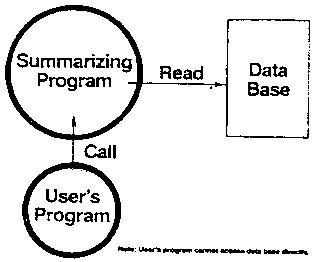
Figure A1
An example of summary information is the total amount of
sales of all companies with headquarters in a given zip code.
If the data user needs to write programs to process these
totals by zip-code he will need to call a program that computes
a total for a particular zip-code. Such a program needs to
read the data base but its caller must be unable to do
so. Current operating systems don’t allow for such programs
with different authority to call each other.
- Here is a second lost business opportunity [Figure
A2]. Imagine another company (which we call the owner) that
creates a data base about chemical patents for its own
use. Suppose that the company then decides that it is good
business to sell access to this data to a competitor. The
competitor has a program to examine entries in the data
base. This competitor is vitally concerned that the nature of
his searches be kept secret. In particular he wishes to keep
this information from the owner of the data base. How do we get
these two guys together?
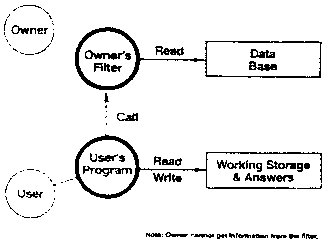
Figure A2
If the search is executed on the data base owner’s machine
the owner might discover the nature of the competitor’s
searches.
The owner wants more money for the whole data base than the
competitor can afford. Thus the search cannot be done on the
user’s machine. (Besides, the data is changing.)
The owner and his competitor agree to run on a computer
utility (which is trusted by both). They agree on a price based
on the number of entries read. The program that counts the
records must be trusted by the owner to send the access count
to him, and it must be trusted by the user not to send anything
else (such as which records were read).
Alternatively, the owner and his competitor may agree that
the competitor can provide a program that has access to the
whole base and the price depends on the amount of the data
returned to the competitor. Current operating systems do not
provide a way to install such programs. We have proposed prices
but no place to put the programs that administer them.
Tymshare wants to generate business in markets such as
these, but finds we can not accomplish this with current
operating systems. In our search for a solution we discerned a
gap between operating system design in the laboratory and in
the commercial world.
When we looked at these kinds of business opportunities and tried
to isolate the underlying weaknesses in our current systems we came up
with the following list of problem areas.
- Authority
-
Once an operating system prevents a program from doing
something that another program can do, some concept of
authority has been introduced.
A general problem with current operating systems is that to
call a program is to give all of your authority to that
program. You must trust all of the programs that you call.
If I write a generally useful program and you use it, my
program can delete all of your files when you call it because
my program runs with your authority when you call it.
If I delete your files you will soon learn not to call my
program. However if my program copies your files into a place
where I can read them, you will be none the wiser.
If I know the format of your files I may subtly sabotage
them for my own ends.
This is called the Trojan horse problem.
Another problem in most operating systems is that a user
cannot install programs that have more authority than their
caller. You can write a program that reads your proprietary
data base but if you give me that program it can only read my
files. If your program must read your files when I run it, you
must give me access to your data base and then your program can
read your data base when I call your program. Unfortunately I
can then read your data base unsupervised by your program.
We have solved some of these problems in VM by putting
these programs in different virtual machines but signalling
between virtual machines is very expensive.
- Pricing flexibility
-
Sellers of programs and data need more flexible ways of pricing
their wares. We have already mentioned the problem of pricing
access to data bases.
Copyrights do not protect against all (or even most)
program theft and seem entirely inadequate for protecting data
bases that change. Detecting and prosecuting violators is
difficult, uncertain and seldom directly productive. If the
violator is at the same time a valued customer it may be
unprofitable to prosecute. (But the loss is still real.)
There are two main ways of pricing data bases currently:
- One approach is to offer the base for $10,000/month. The
user can use the data on his own machine and promises
not to copy it for others.
- Another approach is to keep the data on the data owner’s
machine. The user may or may not he able to provide
programs to access the data in this case. The user who
needs to write a program that depends on proprietary
data bases owned by different owners has no place to run
his program.
Most data base owners will need to segment their market and
sell different products at different prices to the different
segments. In order to avoid maintaining and storing several
related data bases the owner needs to dynamically derive these
other products from his main base. The market will require
pricing in relation to the degree of access to the data. If the
data owner can install programs that have the authority to
access the entire data base and report the degree of usage, the
data base customer can then write programs that call the
owner’s programs but cannot read the complete data base
directly.
Some data base systems (such as IMS) provide for limiting
access to certain fields from certain programs with access
defined~ by other programs, however, many other useful kinds of
limitations can be provided:
Access programs can provide information derived
(irreversibly) from the data base that can be sold at a smaller
price.
One example is the totals by zip-code that we have
mentioned.
Access programs can measure the degree of access and bill
accordingly, perhaps merely counting accessed records.
Another example is the company names (without the gross
revenue) of every company in a data base whose gross is more
than a given constant.
Many other schemes have been discussed for deriving limited
data bases for smaller prices.
It can even be arranged that the data base customer can
write his own program if that program is run in a compartment
where it is prevented from bypassing the billing program by
storing the results where the customer can see it.
- Reliability (in the midst of change)
-
Historically adding new functions has meant less
reliability in old functions. W must not be forced to trade
off extensibility for reliability. While we can’t expect new
software to be perfect we think that we should be able to keep
it form clobbering the other smoothly running function that is
serving real customers and producing revenue.
THE LARGEST PART OF THE COST OF NEW FUNCTION IN THESE
SYSTEMS IS THE CRASHES CAUSED BY THE NEW SOFTWARE THAT
IMPLEMENTS THE NEW FUNCTION.
We have already mentioned the problems of reliable
operating systems. More generally we need to build
applications that are more reliable than we know how to build
with current methods. For this we need not only more reliable
operating systems but ways of organizing application logic so
as to isolate bugs in the application logic as well as those in
the operating system logic.
In current system design an application is dependent on
vast amounts of software working correctly. We call this
software the security kernel of the application. Typically the
great bulk of the security kernel is code that the application
does not even functionally depend on. With current system
design an online application can be killed by the malfunction
of some component that the online application is unconcerned
with. (If the job scheduling crashes the operating system
crashes and the application goes along with it.) How do we
isolate bugs so as to limit their effect to those areas that
really depend on the code with the bug?
Another way an application may fail is to need a resource
that is being monopolized by another program (such as channels
in MVS or VM). IBM calls these problems “denial of resources”
and does not promise to fix them.
- Sharing
-
We need to share access to data and programs in a very
flexible manner.
We need to share user data and code in core as well as on
disk.
These requirements are well known and we will not discuss
them further.
These may sound like problems that are unique to commercial
timesharing companies. We think that they are not.
I understand that General Motors seriously considered a Multics
system for its corporate financial programs because the respective
divisions of GM were extremely concerned that their financial
information not be available to other divisions.
The coincident pressures of new application function and privacy
laws may impact a system’s reliability severely if these problems are
not solved.
1.2 What are we doing about it?
We are writing a completely new operating system designed to the
state of the art as we understand it.
Gnosis provides a way to structure systems of programs. As in
structured programming, it is possible to know relationships between
the programs in the system without examining the programs but only the
structure that connects them.
The ideas to which we are referring have been under development in
the laboratory since 1955 when Jack Dennis wrote some papers that led
to the design of the PDP-1 system in the electrical engineering lab at
MIT. These systems are now generically known as “Capability Based
Operating Systems.” These ideas are perhaps best described in an
issue of Computing Surveys (December 1976, Vol. 8, #4) which is
devoted to the issue of reliable software.
In designing a capability based operating system we have taken
more ideas from new programming languages than from new operating
systems. Programming languages have recently been designed to provide
the same sort of separation for symbolic programs that we are trying
to provide for machine language programs. We have taken more ideas
from SIGPLAN than SIGOPS.
1.3 Gnosis is written for the IBM 370. Why the 370?
The 370 instruction set is less than ideal and the memory
protection hardware is awkward, but the 370 architecture has become a
standard:
- There is widely available hardware, even better in the future,
we expect. There are second sources. A wide range of CPU
sizes is available. Gnosis is small enough to run on the
smallest 370 compatible machine that IBM has (4331?) and seems
appropriate for the largest (3033?). (But it has not yet been
modified to use the sectorized disks.)
- Another reason is the widely available software; we hope to do
as well as CMS in running programs that were designed for OS.
Programs that use simple OS facilities and are designed for
arms-length relations with the OS can be moved to Gnosis with
little or know modification (as with CMS). If these programs
are stable there is perhaps little reason to convert them to
use the Gnosis facilities. Compilers tend to be in this
category. Most data base systems do not. Some application
systems are in this category.
- The third reason is that we do not manufacture hardware and so
we cannot control its architecture. The 370 architecture has
an inertia of its own. It will take years for Gnosis to fully
bloom. We anticipate continued availability of the current
architecture (perhaps enhanced).
Tymshare runs VM370 which serves as a marvelous womb for a new
operating system.
1.4 This project has been going on for nearly three years
now.
Most of the privileged code has been written and debugged.
A dozen modules, normally considered an integral part of the
operating system, but here written in problem state, have been
finished.
The CMS editor and an extensive machine language debugger (DOT)
have been imported and specialized for Gnosis.
No module yet written for Gnosis has been larger than a (core)
page of code. The editor and debugger which are much larger were
imported.
1.5 Why is Tymshare doing all of this?
We see a developing market that we want to be strong in. This is
the data market and to a lesser extent the program market.
It is a substantial job to write an operating system. This
approach of investing a lot of effort in a long range project is the
same approach that we used with Tymnet. That gamble paid off well for
Tymshare. While the ideas of Tymnet had not been tested, the ideas of
Gnosis have in large part been tested in the laboratory. We don’t
know whether we will succeed again but this is how we made the case to
the corporation.
We believe that:
- The advantages of the Gnosis architecture are sufficient to
allow us to compete in some markets with organizations that
apply several times the technical resources to a given
application area that we do.
- Some markets are vitally dependent on features such as those in
Gnosis and thus will not exist without such systems.
- There will be a large data market that can only be served by a
centralized data market place.
- The data market may be much larger if architectural features
such as those in Gnosis are available for use there.
- These design ideas will allow a small group to attack critical
applications soon while at the same time creating the basis for
a powerful and general system later.
We are going to describe these ideas in more detail now. Bill
Frantz is going to describe how Gnosis addresses these problems.
2. Gnosis Design Concepts
Bill Frantz
What is Gnosis? How do we attack the problems of authority,
pricing flexibility, reliability amid change, and sharing that Norm
has described? Let’s look at the key ideas.
2.1 Firewalls
The first key idea I wish to discuss is “firewalls”. The
familiar expression “good fences make good neighbors” applies to
programs as well as to people [Figure B1].
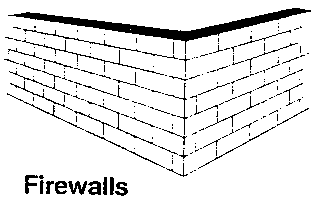
Figure B1
Firewalls are barriers that prevent one section of an application
from affecting other sections except thru well defined interfaces.
The most common kind of firewall is the kind provided by OS between
jobs or by VM between virtual machines. Gnosis provides this kind of
protection between parts of an application as well as between
applications. Gnosis does this by allowing a program to be broken up
into many pieces which we call “domains” [Figure B2]. Each domain
has its own address space, registers, PSW, and authority. The
authority of a domain is represented by tokens called
“capabilities”. These capabilities are kept in operating system
space and manipulated by system calls.
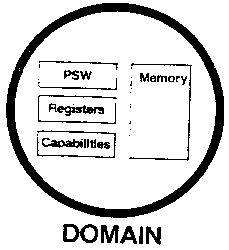
Figure B2
Capabilities represent such diverse authority as the authority to
expend resources, the authority to access a particular piece of data,
and the authority to call a particular program. Domains communicate
with each other by invoking their capabilities with system calls. The
programs in the domains may be written in Fortran, Cobol, PL/I,
Assembler, Pascal, Algol68 or any other language appropriate to the
application.
2.1.1 Comparison with Other Systems
Let us compare Gnosis firewalls with the firewalls in other
existing systems.
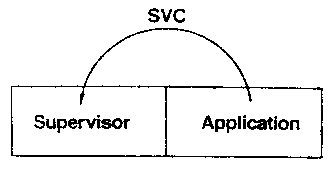
Figure B3
[Figure B3] The SVC instruction in OS lets a program efficiently
call another program that has more authority than it has. Since, even
with APF, there are only two authority levels (user and God), it is not
possible to separate sections of an application from each other as can
be done in Gnosis. There is no easy way to call a program with less
authority than the calling program.
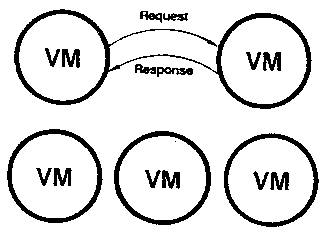
Figure B4
[Figure B4] The VMCF facility in VM/370 allows a program to invoke
a function in a different virtual machine. This other virtual machine
can have less, more, or in general different authority than the
calling virtual machine. In this sense a virtual machine is like a
Gnosis domain; however VM does not allow the passing of authority from
one virtual machine to another. The analogous Gnosis facility is also
fifty to one hundred times faster than VMCF.
2.1.2 What do these firewalls gain us?
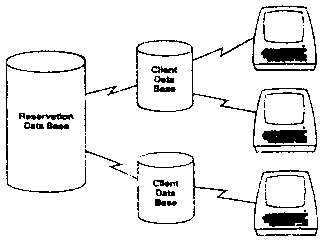
Figure B5
[Figure B5] Let us take as an example a reservation system. The
reservation system will have different clients, each with its own set
of files for such things as accounting data. The files for each
client must be protected from access by other clients because the
clients are competitors and their data is proprietary. Each client
may have several terminals in his office. The programs controlling
these terminals should be isolated form each other to allow them to be
separately scheduled, and for conceptual simplicity. Each of these
clients accesses the main reservation database which must be updated
in only certain controlled ways. Let us see how Gnosis lets us
structure this application in new ways and the advantages that accrue
when we do this.
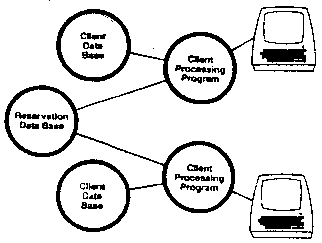
Figure B6
[Figure B6] The first thing we gain is enhanced protection.
The main reservation database, along with the code that maintains
it, can be protected from the code that accesses it. This forces all
accesses to comply with the required procedures. This also protects
the database from failures in the client code and protects the clients
code from failures in the database code. This kind of assured
protection greatly aids in locating the failing module when a failure
occurs.
The second thing we gain is isolation which prevents entangling
alliances between domains.
Each of the client databases is isolated from the code that
performs various client oriented applications (e.g. accounting). This
in turn is isolated from the code that drives the terminals. These
domains can not read or write each other’s memory. They can only
communicate thru the capabilities they hold to each other. This
prevents the large number of implicit interactions between modules
that we see in current monolithic applications.
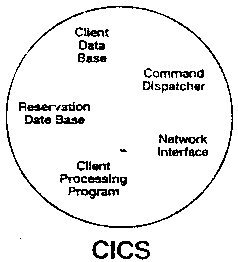
Figure B7
[Figure B7] In CICS the implicit, but undocumented, interactions between
modules allow a relatively unimportant transaction with a bug in it to
do a wild store and take down the whole CICS region. This affects
those transactions on which the organization is vitally dependent. In
Gnosis, on the other hand, the transaction processing modules can be
written to execute in different domains from each other and from the
general support modules. This will prevent wild stores from affecting
the whole application.
The third thing we gain is auditability by external
monitors [Figure B8].
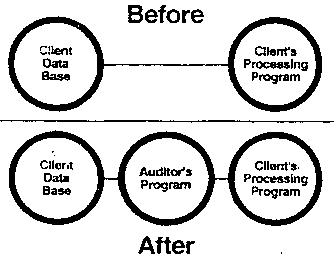
Figure B8
When the external interfaces of a module, application, or even an
application complex are well defined, an auditor can go in and monitor
the information passing over the interfaces and have some assurance
that the programs are behaving as they do in the real production
environment. In our example, an auditor might want to monitor the
transactions to one client’s database. An authorized use can insert a
monitor module between the client’s application software and the
database domain.
Another auditing benefit is that when many small modules are coded
instead of a few large ones it is much easier to verify, by either
formal or informal means, that each module does what it is supposed to
do. Gnosis enforces the interface between domains making clear what
is part of the interface and what is not.
The fourth thing that we gain from this structure is better
machine resource monitoring.
When it comes time to attempt to tune this sample application for
performance, Gnosis allows machine resource usage to be monitored at
the module level. This provides a very powerful tool for performance
auditing of the system.
The fifth thing that we gain is conceptual simplicity. This means
that you only need to know the external specifications [Figure B9].

Figure B9
A very successful example of conceptual simplicity is the 370
microcode. The microcode is complex internally, but the interface
definition is simple. The user of the 370 does not need to know about
how the microcode implements the instruction set, he only needs to
know the external specifications in Principles of Operation,
a much easier task. Gnosis programs have the sam feature. They can
be either simple like the model 115 microcode, or complex like the
3033 microcode. It doesn’t matter to the user of the program; he sees
only the externally defined interface.
2.2. Hiding Things
The second important idea in Gnosis that I want to talk about is
“hiding things.”
In Gnosis it is possible to hide the details of the implementation
of certain functions from the programs that use those functions.
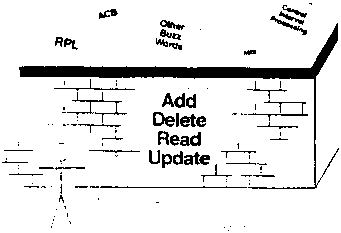
Figure B10
[Figure B10] Hiding things allows us to reduce the conceptual
complexity of certain functions. In our example the complexity of the
database can be hidden behind an interface that just provides for
retrieval, update, insertion, and deletion of reservations. This
allows the programmer who is manipulating the data to ignore all the
many facets of the database, for example performance options, that are
not relevant to his current problem.
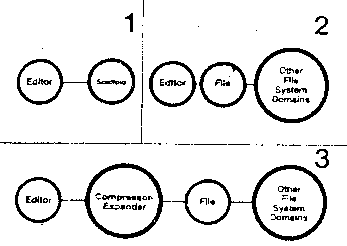
Figure B11
Hiding things allows the easy upgrading of functions in a system.
A function can start off as a scaffold. This has already proven
useful in the Gnosis development project. We were able to move the
CMS editor to Gnosis before there was a file system for it by building
a scaffold module that met the necessary interface [Figure B11]. This
allowed us to debug the editor module, including its file system
calls, before we could store files. We can later develop the real
file system code. After the basic file system is running we can
consider an extension that allows files to be stored in compressed
format. This can be a front end module which meets the same interface
as the file system but compresses the data going into the file system
and expands it again coming out. Note that this enhancement requires
no changes to either the editor or the file system.
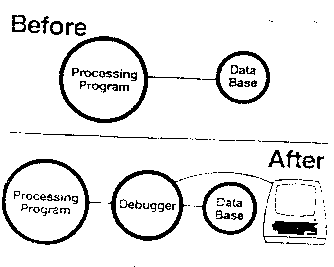
Figure B12
Hiding things can be used to allow debugging or monitoring
interfaces [Figure B12]. We saw earlier how a module can be inserted
between two domains to monitor all the information that goes back and
forth on the interface. The programs involved can not notice that
this has been done and so can not change their behavior. This can be
a very powerful tool for program audit or debugging.
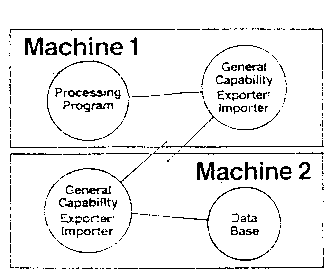
Figure B13
Hiding things is useful for implementing a distributed processing
system. In Gnosis distributed systems can be implemented by a program
that exports capabilities over TYMNET to other computers on the
network [Figure B13]. In our example there is no need for the
reservation database to be on the same machine as the client’s
processing programs. This is hidden in such a way that a program need
not be aware whether another program it calls is on the same computer
of another, geographically separate, computer.
Hiding things is normally implemented in Gnosis by a technique
called “procedural access to data or capabilities.” This is a
technique where a separate program is called to use the data and/or
capabilities. When it is used with data it allows the source and
storage format of the data to vary without impacting the program that
is using the data.
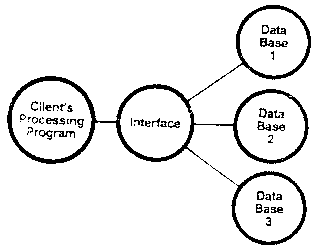
Figure B14
[Figure B14] In our example we could allow programs to access many
different kinds of reservation databases, each with its own access
procedures and protocols. These protocols would be translated to a
common protocol by an interface module. The use of this interface
module would be transparent to the client’s processing programs.
2.3. User Replaceable Units
The last key idea I with to discuss today is “user replaceable
units.” This idea leads directly to the end of monolithic operating
systems.
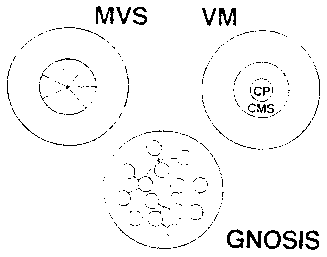
Figure B15
Operating systems have had the problem of trying to control size
and complexity [Figure B15]. MVS, for example, has divided the privileged code
into seven protecting keys as an attempt to isolate parts of the
operating system from each other. VM has divided its operating system
function into the protected security kernel which is called CP, and
the unprotected function, which includes directories and virtual
storage management, which is called CMS.
Gnosis is built with a small amount of supervisor state code,
about 50K. This kernel provides, among other things, the virtual
memory and rudimentary dispatching, and it enforces the definitions of
domains and capabilities. All the rest of the system is built out of
domains, many more than the seven protection key domains in MVS. In
fact all the parts of the system that we are talking about today are
implemented in domains. If you don’t like the function of the domains
provided with the system you can replace them. With proper authority,
you can replace such things as command language interpreters and
spooling systems with new or different ones. this may be done for one
user or for groups of users. It may be done either by users or by
systems people. there may be several versions of, for example,
command languages on one system to serve the different needs of groups
such as secretaries and programmers.
The end of monolithic operating systems leads naturally to the
idea of the end of monolithic applications [Figure B16].
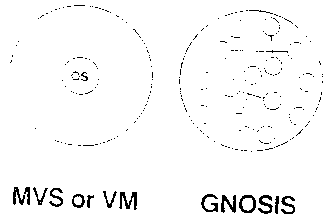
Figure B16
Gnosis will support applications designed to use the OS interfaces
in a manner similar to the way CMS does. We expect the conversion
process to be very similar to an OS to CMS conversion. When a
monolithic application is first converted to Gnosis it will not
automatically gain any of the advantages we have talked about. It
will run as it ran under OS or CMS. If it is desired the application
may later be broken into several domains. Whether the application is
split into multiple domains or not, it can be treated as a single
“black box” by other domains in the system.
For new applications Gnosis offers application programmers new
ways to solve the problems of size and complexity. Traditional
applications have many holes in the walls between modules. While they
may look simple, the implicit interactions mean that you have to read
every line of code in order to find what interfaces were actually
implemented. Under Gnosis the same tools that are used to control the
size and complexity of the operating system, debug the operating
system, and monitor the performance of the operating system are also
available to the application programmer. As we have seen from our
example, by coding applications in many small domains that are
protected from each other it is much easier to add new function or to
enhance existing function without introducing bugs in remote areas of
the application.
I would like now to introduce Charlie Landau, who will describe in
more detail how domains are organized and how they communicate with
each other.
3. The Implementation of Gnosis
Charlie Landau
I want to describe in more detail now the mechanisms in Gnosis
that we use to implement the features you’ve just heard about.
3.1. Domains
The most important basic concept in Gnosis is that of a domain.
The word comes from the phrase “protection domain.” A domain is the
thing which is surrounded by firewalls. All the programs I’m going to
talk about run in domains.
The important thing to remember about a domain is that it has its
own PSW and registers, its own address space, and its own set of
capabilities.
3.2. Capabilities
Capabilities are the tokens of authority. They are the doors in
the firewalls. Owning a capability gives a domain the right to do
something.
The principal mechanism for using capabilities is called
“invocation.” When a domain executes a certain SVC, one of the
capabilities owned by the domain is invoked. That means that
something is done with the capability. What is done depends on the
capability and on the parameters passed by the invoking domain. The
domain can pass as parameters some data and a few capabilities.
Note that a domain has no way to do anything with a capability
unless it owns it. It can’t even name a capability it doesn’t own.
Note also that it makes no difference what domain invokes the
capability. A capability is the same in the hands of any domain..
Thus, owning a capability not only gives you the right to use the
capability, it gives you the power to confer that right on others by
giving them the capability. Every capability can be copied.
The most interesting type of capability is the entry capability
[Figure C1].
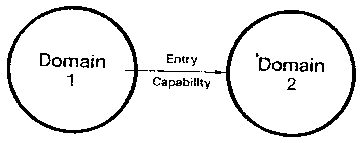
Figure C1
The circles are domains, and the arrow represents an entry
capability.
An entry capability points to a domain. An entry capability to a
domain is like “call only” access to the domain. The caller and
callee have different address spaces and different sets of
capabilities. The called domain may have less authority than its
caller or it may have more authority, or the authorities of the two
programs may be unrelated.
When an entry capability is invoked, that domain is started up and
it is given the parameters that were passed by the caller. By this
mechanism, “what is done” when the capability is invoked is under
control of a program and therefore can be completely general.
Any typical user can write programs that are run when entry
capabilities are invoked. The mechanism is not restricted to system
programmers.
When a domain is called via an entry capability, it gains the
authority to return to its caller. Naturally, this authority is
represented by a capability, called an exit capability. Exit
capabilities can be stored, passed, and shared like any other
capability. There is no call/return stack in the kernel.
Bill mentioned some applications, such as auditing and debugging,
which involve hiding things from the user of a capability. This is
possible because there is no way to identify a capability that you
own. A program knows what to expect of its capabilities only because
it knows how it got them. What is actually on the other side of the
capability is completely hidden from the user of the capability.
This makes it possible to substitute one capability for another
without having any effect on the program using the capability. This
is one reason why almost any part of the system can be replaced by a
properly authorized user.
3.3. Firewalls on implicit actions
We have seen how capabilities can be used to control the
explicit interactions of a program with its environment. There
are several ways in which a program interacts implicitly with
its environment. In Gnosis there are firewalls on all these
interactions as well, and the interactions can be controlled by
the program designer using capabilities. There are three
classes of implicit interactions.
3.3.1. Program Checks
The first class is that of program checks.
When a program causes a program check, something happens.
What happens? Well, you usually don’t find out what happens by
reading the program listing in the vicinity of the trapping
instruction. The program takes some action that is implicit.
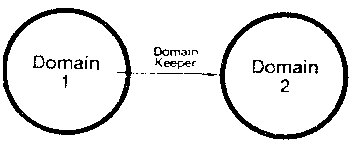
Figure C2
[Figure C2] In Gnosis, each domain holds a capability
which is designated the “domain keeper.” When a program
causes a program check, the domain keeper is invoked and
is passed information relating to the problem. Because
the domain keeper can be an entry capability to a domain
which is executing a user-written program, any recovery
algorithm can be implemented. Probably most domain
keepers will be entry capabilities to a debugger.
3.3.2. Resource Exhaustion
The second class of implicit interactions has to do with
usage of certain resources.
As a program runs it is using resources such as CPU time.
Because the policies for allocating such resources will
probably vary from time to time and from application to
application. Gnosis provides a mechanism for implementing
such policies using capabilities.
For example, there could be a policy to give a particular
application one hour of CPU time between the hours of 5 PM
and 9 PM every Friday.
In Gnosis this could be implemented this way [Figure C3].
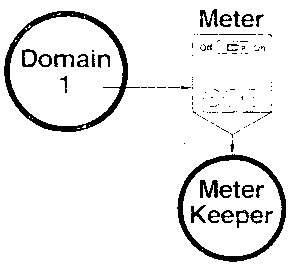
Figure C3
A domain has a capability called a meter capability
which governs its use of CPU time. When the meter is
turned on, the domain can run. When the meter is turned
off, the domain is suspended until the meter is turned
on again. Turning a meter off stops a domain
non-destructively. That is, the domain can be stopped
and restarted without influencing the logic inside tie
domain.
The meter keeper is the program that has the authority
to throw the switch. This program can turn the meter on
during the times it wants to allow the domain to run.
There is also a counter built into the meter that turns the
meter off after a certain amount of CPU time has been used.
The meter keeper can set this to limit the amount of resources
used by the domain.
The meter capability held by the domain allows it to use
resources from the meter but does not give it the authority to
change the limit or throw the switch.
3.3.3. Memory References
The third class of implicit interactions is memory
references.
A domain owns a special capability which defines its memory
space. This capability will be the root of a tree of
capabilities. At the leaves of the tree are capabilities to
pages.
Let me describe what can be done with memory trees by
giving a couple of examples of how they can be used.
The first is an example of sharing memory.
Consider a database system. It has several clients,
each with his own database. Each client can be making
several transactions at once.
Here is how the memory structure for such a system might
look [Figure C4].
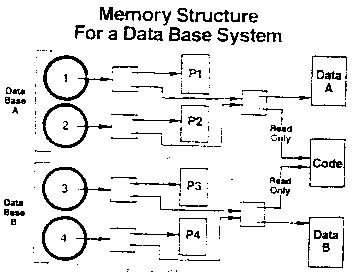
Figure C4
We have a domain for each transaction that could be going
on at once.
The arrow from domain 1 is the capability which defines
that domain’s address space.
That arrow points to a structure which defines the address
space as consisting of two parts. one part is a collection of
pages labeled ‘P1’. The information in P1 is private to domain
1 because no other domain has access to it. Domain 1 could
store there the information pertaining to the transaction it
was processing. Domain 2 likewise has its own private storage,
P2.
The other part of domain 1’s address space is shared with
domain 2. It in turn consists of two parts. The first part
consists of the information in database A. Domains 1 and 2
cooperate to access and update this information.
The last part of the address space is the code of the
database system, which is shared among all four domains. We
assume that the code is reentrant. Access to the code is
restricted to read-only. This eliminates the possibility of a
bug, exercised by database B, clobbering code which would
affect database A.
The second example illustrates what we call a “virtual
copy.”
Let’s suppose now that we have an application which for
some reason was not written in reentrant code. If we
have several people running their own copies of the
application, we must make several copies of the code,
even though in many cases only part of the code is
impure. In other words, we may in fact be able to share
parts of the code, but we don’t want to examine all the
code to find out which parts are pure and which get
modified.
We can solve this problem with the following
structure. 1 and 2 are two domains using the impure code.
The rectangles define a memory map that gives each domain
read-only access to the code [Figure C5].
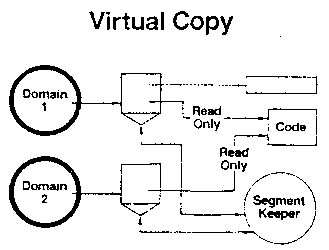
Figure C5
The triangle at the bottom of the map has a special
meaning. It means that if any access violation occurs
through that map, then the accessing domain will not be
given a program check. Rather, the capability leading to
the domain labeled “segment keeper” is invoked, and is
passed information on the access violation.
Now let’s observe what happens when domain 1 tries to
store into the code. Because its access is read-only, an
access violation occurs. The segment keeper is called.
The memory map for domain 2 did not get modified,
nor was the code modified, so domain 2 is unaffected.
All the remaining code is still shared.
The segment keeper that performs the virtual copy
function is a domain that we supply with Gnosis. Of
course, users can write their own segment keepers to
perform different functions.
3.4. The Programmer’s View
So far I’ve talked about the technical details of Gnosis
as viewed by a program running on the system. I’d like now
to mention some aspects of Gnosis from the point of view of
the programmer who is using the system. Our philosophy has
been to keep things simple for the user, and here are some
ways in which we do that.
3.4.1. Single-Level Store
In Gnosis all data is organized in what IBM would call a single
level store. You use the same means for storing two bytes if data
that you use for storing two megabytes of data - namely, you put it in
a virtual memory. In fact, there is a mechanism for constructing
virtual memories larger than you can address at once with the
hardware, so even the largest collections of data can use this one
mechanism.
3.4.2. Perpetual Programs
Another interesting feature of Gnosis is perpetual programs.
In most systems, after a crash it suffices to save the file
system structure.
In Gnosis, there is no file directory that is an obvious
candidate for saving, because there is no single file system.
As often as not, the structures that are important to save are
built and maintained by user programs.
Our approach to deciding what to save after a crash is
very simple. We save everything. We save all data, all
capabilities, the complete state of all domains,
everything.
This means that a program can run forever - through
system crashes, through scheduled maintenance, through
upgrades of the operating system or even the CPU.
The effect of this is that we have provided in essence
a single level store in the time scale. You use exactly
the same technique to install a program whether it is going
to be run once and then deleted, or whether you want it to
still be running a year from now.
Very briefly, the way we save everything is to take a
checkpoint, or snapshot, of the entire system every few
minutes. When recovering after a crash, everything is
restored to its state as of the last checkpoint. The
restart is transparent to most user programs.
3.4.3. Interrupts
Another way we keep things simple for the user is in the area of
interrupts.
Interrupts are a source of complexity in many
applications, such as the reservation system mentioned
earlier. Any structured programming enthusiast will tell
you that if GO TO’s are bad, interrupts are worse. If you
have worked in this area you have probably verified this
from your own experience.
In Gnosis we eliminate Interrupts completely [Figure C6].
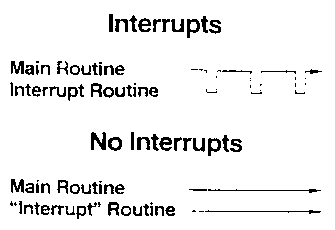
Figure C6
We have a rule that a domain can be doing only one thing at a
time. if it is waiting for input from the terminal, then it
is not sending output to the printer and it is not computing.
When the input from the terminal arrives, the domain will go
on to the next instruction of its program, and not until.
What do we do in place of interrupts? If an
application needs to be doing several things at once, it is
programmed using several domains. Each domain can be
running its own parallel process. Domains are cheap, and
creating parallel processes is cheap. The domains
communicate with each other using capabilities and shared
memory. In this way the interactions of the parts of the
application become explicit and that makes the application
easier to understand.
3.4.4. Device Independence
In Gnosis we encourage true “device” independence.
Because It is so easy to hide things behind entry
capabilities in Gnosis, we make a practice of shielding the
user from the idiosyncracies of hardware devices. For
example, there is a single domain which owns the capability
to operate the network interface. That domain provides a
standardized interface to the programs that call it.
3.5. Summary
I hope by now we’ve given you the idea that Gnosis is a
different operating system. I want to emphasize the two main
points that make Gnosis different.
Programs under Gnosis are built out of protection domains
with firewalls between them. Domains are small, simple, and
cheap.
Domains communicate through doors in the firewalls, called
capabilities. Capabilities are a simple, uniform, efficient
means of representing authority.
Thank you all. Now, before I open the floor for questions, I would
like to add a few comments on how and why we think four people can
build an operating system. When I first joined the project I
thought that it was a pretty ambitious project. There are several
significant factors which make it possible.
- First, and foremost, the Gnosis concept of distinct domains
without implicit interactions between them results in simpler
programs. Because of this, we have had to spend a great deal
of time designing the interfaces between these domains to
insure that adequate function exists in each; but perhaps even
that is a benefit since we will know exactly how the system
goes together. The basic design of Gnosis will ensure that no
compromises to the design occur during the implementation.
- Second, because individual components are completely isolated
from each other, except for the prescribed interfaces, it is a
simple matter to implement each domain independently of the
remainder of the operating system. Very little scaffolding is
required. We went to install the CMS editor in Gnosis and
noted all of the things we thought ought to be there as
co-requisites, things like a command language to call the
editor, a file system, a loader, catalog facilities, and so on.
To our surprise, we discovered that we didn’t need any of those
facilities. We could just connect the editor directly to the
terminal handler and test it. This made development go much
quicker.
- Third, we have been able to coexist with, and take
advantage of, CMS during the early going. We expect to use CMS
services for quite some while for compiling programs and so
forth. Thus our “critical mass” of code is very much smaller
that it would otherwise be.
- Fourth, the basic design of Gnosis allows us to write most
of the operating system as user code, which means we will be
able to eliminate a lot of duplication of effort in terms of
testing tools, etc. The system will also be much simpler
because all of the details of the hardware are masked in the
kernel. Consequently no domain programmer need ever deal with
them, which makes the domains simpler, and also greatly reduces
the impact of any hardware changes.
We have tended to follow the advice of Fred Brooks in the
Mythical Man-month, where he suggests “be prepared to
throw the first one away.” We have implemented each domain
with the simplest possible algorithms in order to test the
design. Later we will have to discard many of these domains
and rewrite them with high performance algorithms which obey
the same interface specifications. Most of these first attempt
domains can be implemented In a matter of days.
- Last, but certainly not least, we have a relatively high
technology “office of the future” system called AUGMENT which
we are using to keep all of our design notes as well as our
user documentation. The use of this system,will save us a
significant amount of labor as we develop a user community over
the next several years.
The combination of these facilities has made it possible for us to
implement a great deal of function very quickly. As Norm mentioned
earlier, we have only just started running our first domains recently.
Yet we expect to be able to have a significant online database
application operational within a year.
That concludes the formal part of this presentation. I will now
open the floor for questions.
The original version of this document was created using
Augment, a hypertext system built by Doug Engelbart while at
Tymshare. Augment, and its predecessor NLS (also by Engelbart), were
the very first online hypertext systems. Unfortunately, the
electronic original of this document has been lost. This text was
rekeyed from a paper copy. I attempted to correct spelling errors in
the original as I found them, so any typos you find in this version
are probably my fault.
In the course of rekeying the document, it became painfully clear
that Augment’s use of indentation did not translate well into HTML.
Eventually, I gave up on it. I have added headings, converted things
to bulleted and numbered lists in some places, and removed some
paragraph breaks for the sake of better flow. The end result conveys
the same content, but it reads more like a paper document than like
the Augment version. Since the format has changed drastically in any
case, I’ve also inlined the figures, which were shown as slides at the
presentation. The figures were scanned from an nth generation
photocopy of the presentation materials. If some kind soul feels like
regenerating them I’ld be delighted to adopt clearer versions.
-- shap
Today is 2009 and I have made minor updates with the aid of modern spell checkers while exploiting slightly more modern web technology.
— norm























